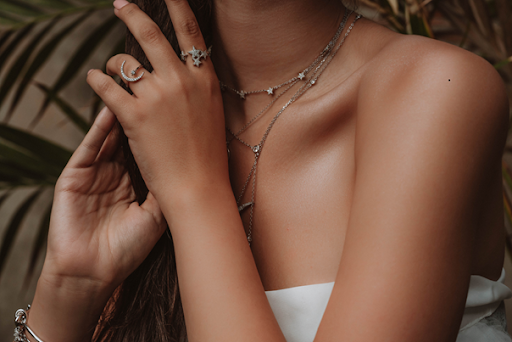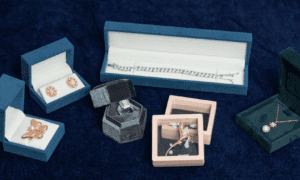Custom jewelry offers a unique opportunity to wear a piece that reflects your personal style, story, or sentiment. Whether it’s an engagement ring designed to symbolize your love, a necklace commemorating a milestone, or earrings crafted to match your aesthetic, custom pieces stand out in a world of mass-produced accessories. But is custom jewelry worth the investment? This guide explores the benefits, challenges, and key considerations to help you decide if custom jewelry is right for you. From costs and timelines to choosing the right jeweler, we’ll cover everything you need to know before placing your order. We’ll also highlight insights from renowned brands like Fiyonk Jewelry, known for their craftsmanship, to provide a balanced perspective.
What Is Custom Jewelry?
Custom jewelry is designed and crafted specifically for you, often from scratch, based on your vision, preferences, and requirements. Unlike off-the-shelf pieces, custom jewelry allows you to choose everything from the metal and gemstones to the design details, ensuring a one-of-a-kind result. This process can range from fully bespoke creations, where every element is unique, to semi-custom designs, where you personalize an existing template. The appeal lies in its exclusivity and personal significance, but it comes with considerations like cost, time, and complexity.
The Benefits of Custom Jewelry
- Uniqueness and Personalization
Custom jewelry is tailored to your taste, making it unlike anything else. Whether you’re incorporating a family heirloom gemstone, engraving a meaningful message, or designing a piece inspired by your favorite artwork, the result is uniquely yours. This level of personalization is ideal for significant occasions like engagements, anniversaries, or gifts.
- Perfect Fit and Comfort
With custom jewelry, you can ensure a perfect fit, especially for rings or bracelets. Jewelers take precise measurements and can adjust designs to suit your comfort, such as creating a low-profile setting for active lifestyles or a curved band to complement an existing ring.
- Emotional and Sentimental Value
Custom pieces often carry deep meaning. For example, a necklace with your children’s birthstones or a ring designed with your partner’s input can become cherished heirlooms. The collaborative process of creating the piece adds to its emotional weight.
- Control Over Materials and Quality
You choose the materials, from the metal (gold, platinum, silver) to the gemstones (diamonds, sapphires, emeralds). This allows you to prioritize ethical sourcing, like conflict-free diamonds or lab-grown stones, and ensure high-quality craftsmanship. Reputable jewelers, like globally recognized Fiyonk Jewelry, emphasize quality, giving you confidence in your investment.
- Versatility in Design
Custom jewelry lets you create pieces that match your wardrobe or occasion. Want a ring that transitions from day to night? Or earrings that complement your wedding dress? A custom design ensures versatility and alignment with your style.
The Challenges of Custom Jewelry
- Higher Costs
Custom jewelry often costs more than mass-produced pieces due to the time, labor, and materials involved. Fully bespoke designs require extensive design work, while even semi-custom pieces may incur additional fees for modifications. Costs vary based on complexity, materials, and the jeweler’s expertise.
- Longer Timelines
Unlike buying ready-made jewelry, custom orders take time. The process includes consultations, design drafts, material sourcing, and crafting, often spanning 4–12 weeks or more. Rush orders may be possible but can increase costs or compromise quality.
- Decision Fatigue
With endless options for metals, stones, and designs, the process can feel overwhelming. Without clear guidance, you may struggle to finalize choices or worry about making the “wrong” decision.
- Limited Returns or Refunds
Custom jewelry is made specifically for you, so most jewelers have strict no-return policies unless there’s a manufacturing defect. This makes it critical to be certain about your design before production begins.
- Finding a Reliable Jeweler
Not all jewelers have the expertise or resources to deliver high-quality custom pieces. Poor communication, subpar craftsmanship, or hidden fees can lead to disappointment. Researching and vetting jewelers is essential.
Is Custom Jewelry Worth the Investment?
The value of custom jewelry depends on your priorities. If you crave a unique piece with personal significance, the cost and time may be justified. For example, a custom engagement ring designed with your partner’s favorite gemstone can feel priceless. However, if you’re looking for affordability or immediate availability, ready-made jewelry from trusted brands may be a better fit. Consider these factors to decide:
- Budget: Can you afford the higher upfront cost? Are you willing to invest in a piece you’ll wear for years?
- Timeline: Do you have enough time for the design and production process?
- Purpose: Is the piece for a special occasion, like a wedding, or everyday wear? Does it hold sentimental value?
- Style: Do you have a specific vision that off-the-shelf jewelry can’t fulfill?
For many, the emotional and aesthetic rewards outweigh the challenges, especially when working with a skilled jeweler who brings your vision to life.
Key Considerations Before Ordering Custom Jewelry
- Set a Realistic Budget
Determine your budget early, accounting for design fees, materials, labor, and taxes. Be transparent with your jeweler about your limits to avoid surprises. For example, lab-grown diamonds or alternative gemstones like moissanite can reduce costs without sacrificing sparkle.
- Research Jewelers Thoroughly
Choose a jeweler with a strong reputation for custom work. Look for reviews, portfolios, and certifications (e.g., from the Gemological Institute of America). Brands like Fiyonk Jewelry are known for their craftsmanship, but local artisans or independent designers may also offer exceptional service. Schedule consultations to assess communication and expertise.
- Understand the Design Process
The custom jewelry process typically includes:
- Consultation: Share your vision, budget, and preferences. Bring inspiration photos or sketches.
- Design Drafts: Review sketches or 3D renderings. Request revisions if needed.
- Material Selection: Choose metals, gemstones, and settings. Ask about ethical sourcing.
- Production: The jeweler crafts the piece, which may take weeks.
- Final Approval: Inspect the finished piece before taking it home.
Ask your jeweler to outline their process and timeline upfront.
- Communicate Clearly
Be specific about your preferences, including style, size, and comfort. If you’re unsure, ask for recommendations. Provide feedback promptly during the design phase to avoid costly changes later.
- Request a Detailed Contract
Before committing, get a written agreement detailing the design, materials, cost, timeline, and policies on revisions, refunds, or repairs. Ensure all verbal promises are documented.
- Prioritize Comfort and Durability
Consider how you’ll wear the piece. For daily wear, choose durable metals like platinum or 14k gold and secure settings for gemstones. For occasional wear, you can opt for more delicate designs.
- Plan for Maintenance
Custom jewelry requires care to maintain its beauty. Ask your jeweler about cleaning, storage, and repair services. For example, diamond rings need regular cleaning to retain their sparkle, while softer stones like opals require gentle handling.
Tips for a Successful Custom Jewelry Experience
- Start Early: Begin the process 3–6 months before you need the piece, especially for engagement rings or wedding jewelry.
- Gather Inspiration: Create a mood board with photos, colors, or styles you love. Pinterest or Instagram can spark ideas.
- Ask Questions: Clarify anything you don’t understand, from gemstone quality to production timelines.
- Trust Your Instincts: If a jeweler feels unprofessional or dismissive, look elsewhere.
- Document Everything: Keep records of communications, designs, and payments for reference.
FAQs
- How much does custom jewelry cost?
Costs vary based on design, materials, and jeweler. Simple custom pieces start at $500, while complex designs with high-quality gems can exceed $5,000. - How long does it take to make custom jewelry?
Most custom orders take 4–12 weeks, depending on complexity and the jeweler’s schedule. Rush orders may be available for an extra fee. - Can I use my own gemstones in custom jewelry?
Yes, many jewelers can incorporate heirloom or personal gemstones. Discuss feasibility and setting options during your consultation. - Is custom jewelry more expensive than ready-made?
Generally, yes, due to design and labor costs. However, semi-custom designs or affordable materials can keep costs comparable. - What if I don’t like the final piece?
Most jewelers don’t offer refunds for custom work, but some allow revisions for a fee. Review designs carefully before production. - How do I find a trustworthy jeweler for custom work?
Research reviews, portfolios, and certifications. Schedule consultations to assess communication and expertise. - Can I customize an existing jewelry design?
Yes, semi-custom options let you tweak existing designs, like changing a gemstone or metal, often at a lower cost than fully bespoke pieces. - Are lab-grown diamonds a good choice for custom jewelry?
Lab-grown diamonds are affordable, ethical, and visually identical to mined diamonds, making them a popular choice for custom pieces. - What should I include in my custom jewelry contract?
Ensure it covers design details, materials, cost, timeline, revisions, and refund or repair policies. - How do I care for custom jewelry?
Follow your jeweler’s care instructions. Clean regularly, store properly, and schedule professional maintenance as needed.



































